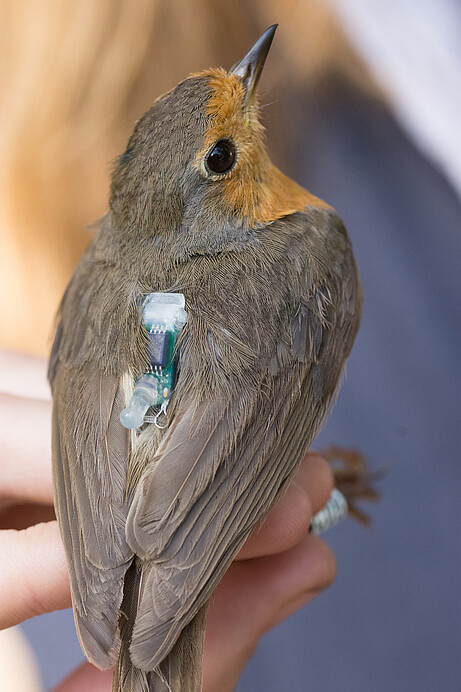



Tracking migratory animals in the wild
During migration, birds cover long distances, often crossing continents. How can we study this behaviour without affecting the birds' behaviour or compromising their survival? While battery life and possibilities for autonomous energy supply are increasing, tracking devices (radio transmitters, light-level geolocator archival tags, radar and satellite tracking) at the same time are getting lighter. The most informative data come from global positioning system (GPS) satellite transmitters, where real-time recording of the signal by satellites enables the monitoring of migratory movement around the globe. The use of this technology, however, is not yet possible for real-time monitoring of smaller passerines, such as the European blackcap, which weighs less than 20 gram, or small seabirds, such as the common tern, which weighs c. 125 gram. As such, for most of the species studied at the Institute of Avian Research, we use alternative technology, such as archival tags that record and store light-intensity data (i.e. light-level geolocators), or radio-transmitters and telemetry systems.
Publications
Wynn J, Kürten N, Moiron M, Bouwhuis S (2025) Selective disappearance based on navigational efficiency in a long-lived seabird. Journal of Animal Ecology 94: 535-544
Kürten N, Wynn J, Haest B, Schmaljohann H, Vedder O, González-Solís J, Bouwhuis S (2025) Route flexibility is associated with headwind minimization in a long-distance migratory seabird. Proceedings of the Royal Society B 292: 20242522
Bertram J, Kürten N, Bichet C, Schupp PJ, Bouwhuis S (2022) Mercury contamination level is repeatable and predicted by wintering area in a long-distance migratory seabird. Environmental Pollution 313: 120107
Kürten N, Schmaljohann H, Bichet C, Haest B, Vedder O, González-Solís J, Bouwhuis S (2022) High individual repeatability of the migratory behaviour of a long-distance migratory seabird. Movement Ecology 10: 5
Van Doren BM, Conway GJ, Phillips RJ, Evans GC, Roberts GCM, Liedvogel M*, Sheldon BC* (2021) Human activity shapes the wintering ecology of a migratory bird. Global Change Biology 27, 2715-2727.doi: 10.1111/gcb.15597
Delmore KE*, Van Doren B*, Conway GJ, Curk T, Garrido-Garduño T, Germain RR, Hasselmann T, Hiemer D, van der Jeugd HP, Justen H, Lugo Ramos JS, Maggini I, Meyer BS, Phillips RJ, Remisiewicz M, Roberts GCM, Sheldon BC, Vogl W, Liedvogel M (2020) Individual variability and versatility in an eco-evolutionary model of avian migration. Proceedings of the Royal Society B 287, 20201339. doi: 10.1098/rspb.2020.1339
Kürten N, Vedder O, González-Solís J, Schmaljohann H, Bouwhuis S (2019) No detectable effect of light-level geolocators on the behaviour and fitness of a long-distance migratory seabird. Journal of Ornithology 160: 1087-1095

